Adaptation U.S. Students (Bachelor, Trade)
Adaptation to the U.S. Students (Bachelor of Science in International Trade, e-learning, fourth semester, second year)
| Bachelor of Science in International Trade |

Syllabus of the Program: U.S. Foreign Trade and Economy
- Introduction to the U.S.
- The U.S. economy
- The U.S. International Trade
- The U.S. Exports of goods and services
- Invest in the U.S.
- United States Free Trade Agreements
Objectives:
- To analyze the U.S. Foreign Trade and economy
- To know the U.S. Free Trade Agreements
Syllabus of the Program: Asia-Pacific Economic Cooperation (APEC)
- Introduction to the APEC
- Structure of the APEC
- Achievements and benefits of the APEC
- Bogor Goals. The Osaka Action Agenda
- Foreign Trade and investments Liberalization in the APEC region
- Foreign Trade facilitation
- Economic and technical cooperation
- APEC Committee on Foreign Trade and Investment
- Economy, Foreign Trade and investments in the region of the Asia-Pacific Economic Cooperation
- Free-Trade Area of the Asia-Pacific
- Trade Agreements related to the APEC
Objectives:
- To understand the Bogor Objectives and the functions of the Asia-Pacific Economic Cooperation
- To evaluate the benefits for the member countries of the APEC as well as the areas of cooperation
- To know the role of the Committee on Trade and Investment of the Asia-Pacific Economic Cooperation
- To analyze the Economic Integration process and the foreign trade between the member countries of the APEC (the free-trade area of Asia and the Pacific)
- To understand the Trade Liberalization and Investment Facilitation between the countries of the APEC
- To explore free trade agreements between the countries of the Asia-Pacific Economic Cooperation
Pacific Economic Cooperation Council.
- Introduction to the Pacific Economic Cooperation Council (PECC)
- PEEC Working Groups
- Services Group: Foreign Trade and investments
- State of the Region Report
- Index of Economic Integration
- Pacific Economic Cooperation Council and the free-trade area of the Asia-Pacific
Syllabus of the Subject - United States-Mexico-Canada Agreement (USMCA/NAFTA 2.0).
- Introduction to the U.S.-Mexico-Canada Agreement (USMCA/NAFTA 2.0)
- Institutions of the U.S.-Mexico-Canada Agreement
- Economic impact of the U.S.-Mexico-Canada Agreement
- Dispute resolution in the Treaty
- Rules of origin of the U.S.-Mexico-Canada Agreement
Objectives:
- To understand the objectives of the U.S.-Mexico-Canada Agreement
- To evaluate the benefits and economic impact for the member countries of the U.S.MCA/NAFTA 2.0
- To analyze the Economic Integration process and the foreign trade between the countries of the U.S.MCA/NAFTA 2.0
- To know the dispute settlement mechanism
- To understand the rules of origin of the U.S.-Mexico-Canada Agreement
Syllabus of the Subject - African Growth and Opportunity Act (AGOA)
- Introduction to the AGOA. The AGOA IV
- Eligibility criteria: countries and products. The case of the African textiles
- Foreign Trade between the U.S. and Africa
- The largest suppliers of Sub-Saharan Africa to the U.S.
- North American Investment in Africa
- African global competitiveness initiative and Africa trade hubs
- Trade Agreements between the U.S. and the African Countries
The objectives of the subject “African Growth and Opportunity Act”:
- To understand the objectives of the AGOA
- To evaluate the admission criteria by country and product eligibility
- To understand the general rules of origin for textiles under the AGOA
- To analyze the access to the U.S. market for the African products under the AGOA
- To know the trade agreements between the African Countries and the U.S.
- To analyze the foreign trade between the African Countries and the U.S.
Trade and Investment Framework Agreement between the West African Economic and Monetary Union and the U.S.
- Introduction to the WAEMU-United States Trade Agreement
- Objectives of the Trade and Investment Framework Agreement
- Foreign Trade between the countries of the WAEMU and the U.S.
East African Community-United States Trade and Investment Agreement.
- Introduction to the Agreement on foreign trade and investments between the East African Community and the U.S.
- Objectives of the U.S.-East African Community agreement
- Foreign Trade between the countries of the EAC and the U.S.
United States-COMESA (Common Market for Eastern and Southern Africa) Trade and Investment Framework Agreements (TIF)
- Introduction to the COMESA-United States Trade Agreement
- Foreign Trade between the U.S. and the COMESA countries
- Content of the COMESA-United States Trade and Investment Agreement
Syllabus of the Subject - United States Free Trade Agreements:
- The U.S. Free Trade Agreements with the American Countries: Chile, Colombia, Peru, Central America and the Dominican Republic, Panama, the Caribbean Basin Initiative
- The U.S. Free Trade Agreements with the Asian Countries: South Korea, Australia, Singapore, ASEAN
- The U.S. Free Trade Agreements with the European Countries: the EU
- Agreements with the Arab Countries: Bahrain, Oman, Jordan, Morocco
- The U.S. Free Trade Agreements with the African Countries: the Trade and Investment Agreement with the countries of the WAEMU and with the COMESA countries, the Trade Agreement East African Community (EAC)
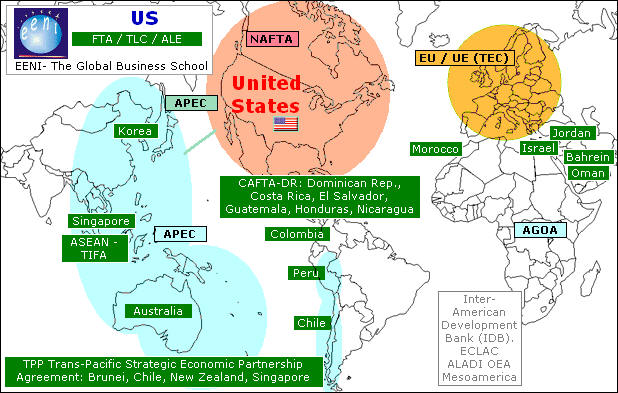
Comprehensive and Progressive Agreement for Trans-Pacific Partnership (CPTPP)
- Introduction to Comprehensive and Progressive Agreement for Trans-Pacific Partnership
- Free trade in goods
- Rules of origin
- Foreign Trade in services
- Enlargement of the Comprehensive and Progressive Agreement for Trans-Pacific Partnership
Free Trade Agreement between Chile and the U.S..
- Introduction to the Chile-United States FTA
- Foreign Trade in Goods and services between Chile and the U.S.
- Chilean Investments in the U.S.
- Intellectual Property Rights
- Certificate of origin
Colombia-United States Free Trade Agreement.
- Introduction to the U.S.-Colombia FTA
- Advantages for exporters and importers
- Trade in services and investments
- Calculation of import tariff
- Foreign Trade Colombia-United States
Peru-United States Trade Promotion Agreement.
- Introduction to the U.S.-Peru Trade Promotion Agreement
- Foreign Trade Peru-United States
- Benefits of the agreement
Free Trade Agreement between Central America, the U.S. and the Dominican Republic (CAFTA-DR).
- Introduction to the Free Trade Agreement between Central America, the U.S. and the Dominican Republic
- Benefits of the agreement
- Certification of origin of the Trade Agreement
- Foreign Trade and investment flows between the Central American countries (Costa Rica, El Salvador, Guatemala, Honduras, Nicaragua) and the U.S.
United States-Panama Free Trade Agreement.
- Introduction to the U.S.-Panama FTA
- Benefits of the Trade Promotion Agreement
- Foreign Trade United States-Panama
Caribbean Basin Initiative (CBI)
- Introduction to the Caribbean Basin Initiative
- The U.S.-Caribbean Basin Trade Partnership Act
- The Caribbean Basin Economic Recovery Act
United States-South Korea Free Trade Agreement.
- Introduction to the Korea-United States FTA
- Benefits of the agreement
- Investments Chapter of the U.S.-Korea agreement
- Rules of origin
- Regional Value Content
- Foreign Trade United States-Korea
United States-Australia Free Trade Agreement.
- Introduction to the Australia-United States FTA
- Advantages for exporters
- Foreign Trade in Goods and services between the U.S. and Australia
- Sanitary and Phytosanitary Measures
- Investment Chapter
United States-Singapore Free Trade Agreement.
- Introduction to the Singapore-United States FTA
- Rules of origin
- Benefits for the exporters
- Foreign Trade United States-Singapore
ASEAN-United States Framework Agreement on foreign trade and Investment.
- Introduction to the Trade and Investment Framework Agreements between the ASEAN and the U.S.
- Foreign Trade ASEAN-US
The future United States-EU Transatlantic Trade and Investment Partnership
- Trade relations between the EU and the U.S.
- Foreign Trade United States-EU
- The future United States-EU Transatlantic Trade and Investment Partnership
United States-Bahrain Free Trade Agreement.
- Introduction to the U.S.-Bahrain FTA
- The main benefits of the agreement
- Foreign Trade US-Bahrain
United States-Oman Free Trade Agreement.
- Introduction to the Oman-United States FTA
- The main benefits of the agreement
- Business opportunities
United States-Jordan Free Trade Agreement.
- Introduction to the Jordan-United States FTA
- The main benefits of the agreement
- Foreign Trade between the U.S. and Jordan
United States-Morocco Free Trade Agreement.
- Introduction to the Morocco-United States FTA
- The main benefits of the agreement
- Foreign Trade between the U.S. and Morocco
United States-Israel Free Trade Agreement.
- Introduction to the U.S.-Israel FTA
- Foreign Trade Israel-United States
Samples of the adaptation to the U.S. Students (Bachelor of Science in Foreign Trade, e-learning, fourth semester, second year):
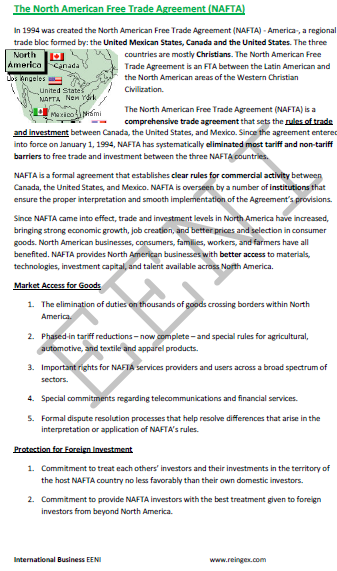
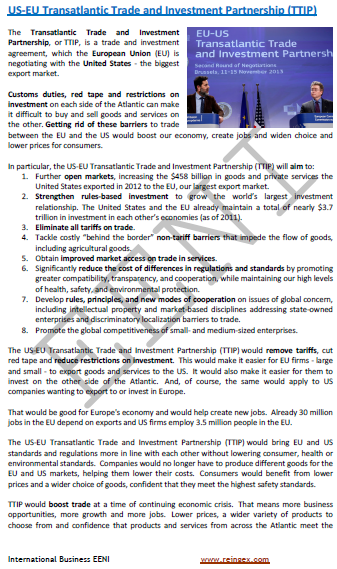
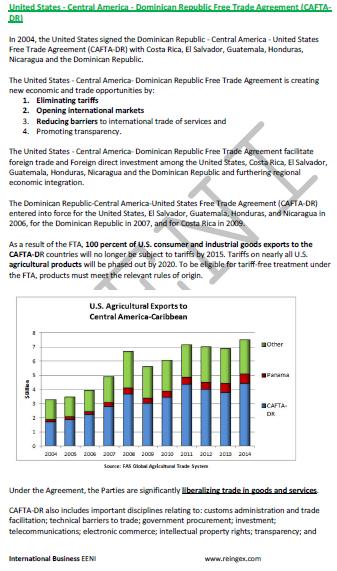
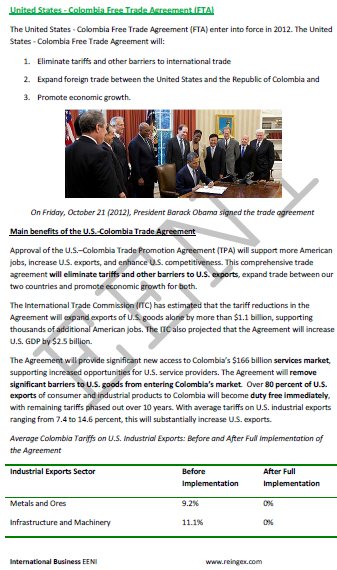
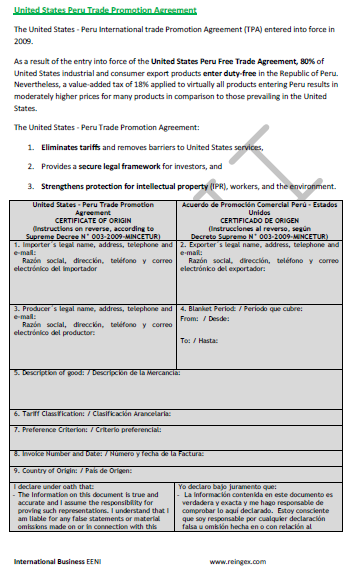
Languages:  or or
or or  EENI
EENI  EENI
EENI  EENI.
EENI.
(c) EENI Global Business School (1995-2024)
We do not use cookies
Top of this page

